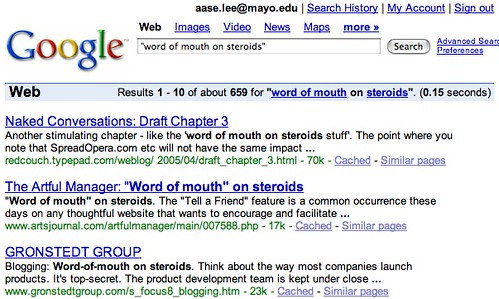Yesterday I finished reading Malcolm Gladwell’s The Tipping Point: How Little Things Can Make a Big Difference.
I enthusiastically recommend this interesting look at how epidemics reach epidemic proportions, and how it sometimes just takes a little nudge at the right point to immensely change the results. The book is full of real-life case studies that illustrate what Gladwell calls the three rules of epidemics: the Law of the Few, the Stickiness Factor and the Power of Context.

The Law of the Few: Certain kinds of people — Connectors, Mavens and Salesmen — play an immensely disproportionate role in spreading a social “virus.” Mavens identify what’s hot or cool, and are the ones who are “in the know.” As Gladwell puts it, they’re not just the kind of people read Consumer Reports; they’re the ones who write to Consumer Reports to correct what they see as errors in product evaluation. Connectors just know more people than the rest of us, often several times more than average, and so when they adopt an idea they will communicate it much more rapidly than others. Salesmen “persuade us when we are unconvinced of what we are hearing, and they are as critical to the tipping of word-of-mouth epidemics as the other two groups.”
The Stickiness Factor: Is the message memorable? Does it engage people? The classic example is the Gold Box in Columbia Record Club’s print advertising, which enabled new members to get any record of their choice free. This simple addition to the membership form in Parade and TV Guide increased sales by four times as much as a simultaneous test that used traditional prime time “awareness” advertising. The Gold Box team won in a rout, even though they spent a quarter of the amount on broadcast ad time as the team using traditional methods.
The Power of Context: The classic example of this is the precipitous decline in crime rates in New York City, which was far more rapid than could be attributed to demographics, crime rates or any other trends that would have pointed to a gradual decline. The key that “tipped” the positive epidemic, and ended the negative one, was zero-tolerance of fare beating or graffiti in the subway system.
The Tipping Point is, in essence, an epidemic that has already tipped; it’s been a #1 national bestseller. I know I’m not an early adopter, but if this post helps to play a Salesman role for you, encouraging you to check it out, I will consider it “mission accomplished.” You also may want to check out and subscribe to his blog.
The book gives a thought-provoking framework for people interested in starting word-of-mouth epidemics or attacking harmful epidemics. It’s interesting, though, that Gladwell doesn’t seem to think the context creation approach used in making subways safe is applicable to drug abuse or teen smoking. For instance, he notes a Baltimore needle exchange program for heroin addicts and apparently doesn’t see that as creating a more permissive/lawless environment similar to the fare-beating or graffiti. Likewise, smoking bans in restaurants and bars create contexts in which smoking is not socially acceptable, and the research on that seems to indicate it significantly reduces smoking. But maybe Gladwell sees drug addictions as just too “sticky” for context to matter as much.
For more on this book, you can check out Gladwell’s overview. I know that because of The Tipping Point, I’m going to be checking out his other book, Blink
.

 Technorati:
Technorati: 


